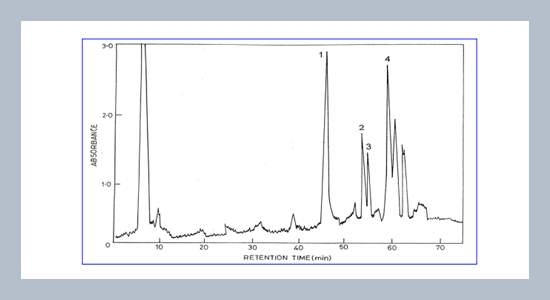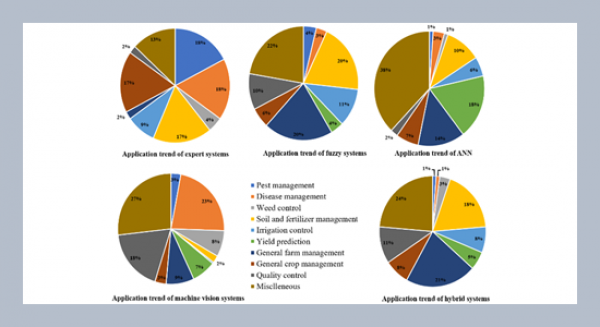G. Purna Chandra Nagaraju*, G. Lakshmi Vara Prasad, and P. Sreenivasula Reddy Department of Biotechnology, Sri Venkateswara University, Tirupati –517 502, India
Download Citation:
|
Download PDF
Eyestalk neuropeptides play an important role in regulating wide variety of physiological processes in crustaceans. The neuropeptides belonging to the crustacean hyperglycemic hormone (CHH) family, influence the secretion of ecdysteroids and methyl farnesoate (MF) and in turn regulate molting and reproduction. Using MF secretion by Mandibular organ (MO) as bioassay two peptides with distinctive Mandibular organ-inhibiting hormone (MO-IH) activity was identified. Among these one peptide possesses hyperglycemic activity.ABSTRACT
Keywords:
eyestalk neuropeptides; mandibular organ; Mandibular organ-inhibiting hormone.
Share this article with your colleagues
[1] Reddy, P. S. and Ramamurthi, R. 1999. Recent trends in crustacean endocrine research. Proceedings of Indian National Science Academy, 65B: 15-32.REFERENCES
[2] Nagaraju, G. P. C. 2003. Mandibular organ: Its role in the regulation of reproduction and molting in the crab, Oziotelphusa senex senex, Ph.D. thesis, Sri Venkateswara University, Tirupati, India.
[3] Wainwright, G., Webster, S. G., Wilkinson, M. C., Chung, J. S., and Rees, H. H. 1998. Structure and significance of mandibular organ-inhibiting hormone in the crab, Cancer pagurus. Involvement in multi-hormonal regulation of growth and reproduction. Journal of Biochemistry, 271: 12749-12754.
[4] Wainwright, G., Webster, S. G., and Rees, H. H. 1999. Involvement of adenosine cyclic - 31, 51 - monophosphate in the signal transduction pathway of mandibular organ - inhibiting hormone of the edible crab, Cancer pagurus. Molecular and Cellular Endocrinology, 154: 55 - 62.
[5] Tang, C., Weiqun, L. U., Wainwight, G., Webster, S. G., Rees, H. H., and Turner, P. C. 1999. Molecular characterization and expression of mandibular organ - inhibiting hormone, a recently discovered neuropeptide involved in the regulation of growth and reproduction in the crab, Cancer pagurus. Biochemistry Journal, 343: 355–360.
[6] Huberman, A. 2000. Shrimp endocrinology. A review. Aquaculture, 191: 191-208.
[7] Borst, D. W., Wainwright, G., and Rees, H. H. 2002. In vivo regulation of the mandibular organ in the edible crab, Cancer pagurus. Proceeding of Royal Society in London B. Biological Science, 269(1490): 483 - 490.
[8] Chang, E. S., Prestwich, G. D., and Bruce, M. J. 1990. Amino acid sequence of a peptide with both moult - inhibiting and hyperglycemic activities in the lobster Homarus americanus. Biochemical and Biophysical Research Communications, 171: 818-826.
[9] Brody, M. D. and Chang, E. S. 1989. Development and utilization of crustacean long term primary cell cultures: ecdyssteriods effects in vitro. International Journal of Invertebrate Reproductive Development, 16: 141-174.
[10] Carroll, N. V., Longley, N. V., and Roe, J. H. 1956. Glycogen determination in liver and muscle by use of anthrone reagent. Journal of Biological Chemistry, 220: 583-593.
[11]Steel, R. D. G. and Torrie, J. H. 1960. “Principles and procedures of statistics with special reference to the biological sciences”. McGraw Hill Book Inc., New York, Toronto, London, XVI: 481.
[12]Abramowitz, A. A., Hisaw, F. L., and Papendrea, D. V. 1944. The occurrence of a diabetogenic factor in the eyestalks of crustaceans. Biological Bulletin, 86: 1-5.
[13] Chan, S. M., Gu, P. L., Chu, K. H., and Tobe, S. S. 2003. Crustacean neuropeptide genes of the CHH/MIH/GIH family: implications from molecular studies. General and Comparative Endocrinology, 134: 214 –219.
[14] Webster, S. G. 1998. Neuropeptides inhibiting growth and reproduction in crustaceans. In “Recent Advances in Arthropod endocrinology”. Editors: Coast G. M. and Webster S. G, Cambridge University Press, Cambridge, 33-52.
[15] Kegel, G., Reichwein, B., Weese, S., Gaus, G., Peter Katalinic, J., and Keller, R. 1989. Amino acid sequence of the crustacean hyperglycemic hormone (CHH) from the shore crab, Carcinus maenas. FEBS Lett, 255: 10-14.
[16] Yang, W. J., Alda, K., and Nagasawa, H. 1995. Amino acid sequence of a hyperglycemic hormone and its related peptides from the kumuran prawn, Penaeus joponicus. Aquaculture, 135: 205-212.
[17] Yang, W. J., Aida, K., and Nagasawa, H. 1997. Amino acid sequences and activities of multiple hyperglycemic hormones from the Kuruma prawn. Penaeus japonicus. Peptides, 18: 479-485.
[18] Chang, E. S., Keller, R., and Chang, S. A. 1998. Quantification of crustacean hyperglycemic hormone by ELISA in hemolymph of the lobster. Homarus americanus, following various stresses. General and Comparative Endocrinology, 111: 359-366.
[19] Nagaraju, G. P. C., Basha, Md. R., and Reddy, P. S. 2001. Organotin –induced hyperglycemia in the crab, Oziotelphusa senex senex Fabricius. Zeait Naturforschung, 56C: 315 - 317.
[20] Nagaraju, G. P. C. and Reddy, P. S. 2002. On the mode of action of Methionine enkephalin in inducing hyperglycemia in the fiddler crab. Uca lactea annulipes. Bulletin of Marine Science 70: 107-111.
[21] Mettulio, R., Giulianini, P. G., Ferrero, E. A., Lorenzon, S., and Edomi, P. 2004. Functional analysis of crustacean hyperglycemic hormone by in vivo assay with wild-type and mutant recombinant proteins. Regulatory Peptides, 119: 189-97.
[22] Kummer, G. and Keller, R. 1993. High affinity binding of crustacean hyperglycemic hormone (CHH) to hepatopancreatic plasma membranes of the crab Carcinus maenas and the crayfish Orconectes limosus. Peptides, 14: 103-108.
[23] Soyez, D., Le Caer, J. P., Noël, P. Y., and Rossier, J. 1991. Primary structure of two isoforms of the vitellogenesis - inhibiting hormone from the lobster Homarus americanus. Neuropeptides, 20; 25–32.
[24] Lu, W., Weinwright, G., Webster, S. G., Rees, H. H., and Turner, P. C. 2000. Clustering of mandibular organ inhibiting hormone and moult inhibiting hormone genes in the crab, Cancer pagurus, and implications for regulation of expression. Gene, 253: 197-207.
[25] Landau, M., Laufer, H., and Homala, E. 1989. Control of methyl farnesoate synthesis in the mandibular organ of the crayfish, Procambarus clarkii; Evidence for peptide neurohormones with dual functions. International Journal of Invertebrate Reproductive Development, 16: 165-168.
[26] Khyayat, M., Yang, W. J., Aida, K., Nagasawa, H., Tietz, A., Funkenstein, B., and Lubzens, E. 1998. Hyperglycemic hormones inhibit protein and mRNA synthesis in in vitro–incubated ovarian fragments of the marine shrimp Penaeus semisulcatus. General and Comparative Endocrinology, 110: 307-318.
[27] Laufer, H., Lui, L., and Van Herp, F. 1994. A neuropeptide that inhibits the mandibular organ of crustacea and may regulate reproduction. In “Insect Neurochemistry and Neurophysiology”. Edi-tors: Borkovec, A. B. and Loeb, M. J. RC press, Boca Raton, 203-206.
[28] Wainwright, G., Webster, S. G., and Rees, H. H. 1998. Neuropeptide regulation of biosynthesis of the juvenoid, methyl farnesoate, in the edible crab, Cancer pagurus. Biochemical Journal, 334: 651 - 657.
[29] Hinsch, G. W. 1977. Fine structural changes in the mandibular gland of the male spider crab, Libinia emarginata (L) following eyestalk ablation. Journal of Morphology, 154: 307-316.
[30] Le Roux, A. 1980. Effect of de l'ablation des pedoncules oculaires et des quelques conditions d'elevage sur le development de Pisidia longicornis (Linne). Archives Zoological Experimental Genetics, 121: 97-214.
[31] Le Roux, A. 1983. Reactions de l'organe mandibulaire a l'ablation des pedoncules oculaires chez les larvaes et les juveniles de Palaemonetes varians (Leach). Compte Rendue de I Academie des Sciences Paris Sėrie D, 296: 697-700.
[32] Byard, E. H., Shivers, R. R., and Aiken, D. E. 1975. The mandibular organ of the lobster, Homarus americanus. Cell and Tissue Research, 162: 13-22.
[33] Dèmeusy, N., 1975. Observations sur le fonctioement des glandes mandibulaires du dėcapode branchyoure Carcinus maenas L: animaux tėmoins ėt animaux sans pėdoncules oculariės - Compte Rendue de I Academie des Sciences Paris Sėrie D, 281: 1887-1889.
[34] Laufer, H. and Borst, D. W. 1988. Invertebrate endocrinology. In “Endocrinology of Selected Invertebrate Types”. Editors: H. Laufer and R. G. H. Downer. Alan. R. Liss. Inc, New York, 2: 305-307.
[35] Liu, L. and Laufer, H. 1996. Isolation and characterization of sinus gland neuropeptides with both mandibular organ inhibiting and hyperglycemic effects from the spider crab, Libinia emarginata. Archives of Insect Biochemistry and Physiology, 32: 375-385.
[36] Li, H. and Borst, D. W. 1991. Characterization of a methyl farnesoate binding protein in hemolymph from Libinia emarginata. General and Comparative Endocrinology, 81: 335-3420.
[37] Tsukimura, B. and Borst, D. W. 1992. Regulation of methyl farnesoate in the hemolymph and mandibular organ of the lobster, Homarus americanus. General and Comparative Endocrinology, 86: 297-303.
[38] Chaves, A. 2001. Effects of sinus gland extract on mandibular organ size and methyl farnesoate synthesis in the crawfish. Comparative Biochemistry and Physiology, 128: 327-333.
[39] Tamone, S. L. and Chang, E. S. 1993. Methyl farnesoate stimulates ecdysteroid secretion from crab Y - organs in vitro. General and Comparative Endocrinology, 89: 425-432.
ARTICLE INFORMATION
Accepted:
2005-02-22
Available Online:
2005-04-03
Chandra Nagaraju, G.-P., Vara Prasad, G.-L., Sreenivasula Reddy, P. 2005. Isolation and characterization of mandibular organ–inhibiting hormone from the eyestalks of freshwater crab, Oziotelphusa senex senex. International Journal of Applied Science and Engineering, 3, 61–68. https://doi.org/10.6703/IJASE.2005.3(1).61
Cite this article:















